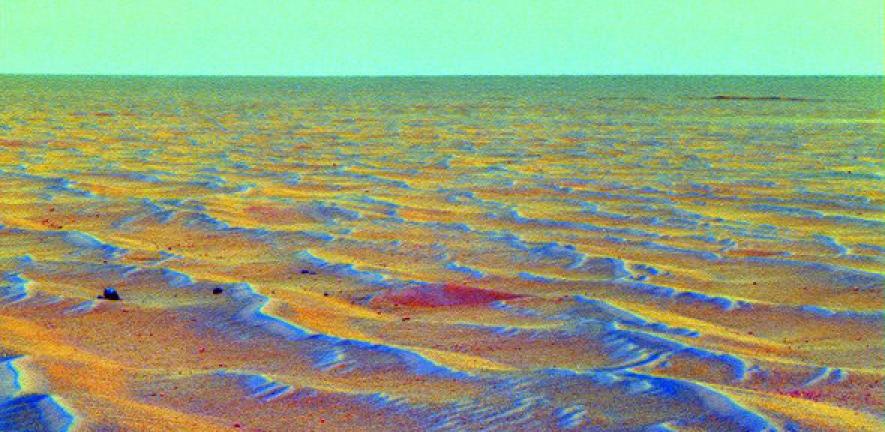
Professor Paul Murdin will be speaking in the Cambridge Series at the Hay Festival about his latest book on planetary landscapes.
Professor Paul Murdin will be speaking in the Cambridge Series at the Hay Festival about his latest book on planetary landscapes.
For me as a scientist, space exploration is about viewing landscapes to imagine the underlying reason that it is both ordinary and strange.
Professor Paul Murdin
What can a picture tell us about our world - and our universe?
Astronomer Professor Paul Murdin says images from outer space can give scientists useful information which they can use to infer what lies behind the image and to imagine what conditions may have caused particular landscapes.
Professor Murdin, Senior Fellow Emeritus at the Institute of Astronomy, has recently published a book drawing parallels between our terrestrial landscapes and space landscapes and will be speaking about it in a session at the Hay Festival on 2nd June as part of the Cambridge Series at the Hay Festival.
Professor Murdin’s talk will include cutting edge images of towering cliffs and icy canyons on distant planets, from mountain ranges on Mars to a volcanic landscape on Venus.
He says such images, in addition to their aesthetic appeal, pique the scientific imagination. “For me as a scientist,” he states, “space exploration is about viewing landscapes to imagine the underlying reason that it is both ordinary and strange.”
In the last few years, thanks to technological advances, the images sent back from space have been increasingly detailed and have prompted speculation about the history of distant planets. Last week, for instance, a report from the Planetary Science Institute stated that mega-tsunamis in an ancient ocean on Mars may have shaped the landscape and left deposits that hint at whether the planet was once habitable.
Professor Murdin decided to write his book, Planetary Vistas. The Landscapes of Other Worlds, as a result of a road trip to the US. He says: “I was in White Sands, New Mexico, and the scenery reminded me of pictures that I had seen of Mars. The idea came to mind of a book about the surfaces of planets and their moons, based on what you would see as a space tourist.”
He says the main differences between territorial and space landscapes are obvious - the lack of vegetation, which is a unique feature to Earth. However, he adds: “There are similarities in the science that generates the unliving structures in the landscape: the violent events like earthquakes, floods or meteor impacts which expose cliffs and the geological history of the planet; the rush of water that rumbles and rounds off boulders in stream beds, whether the streams were water or liquid methane; the deserts of drifting sand and dunes which are evidence of extreme climates.”
His presentation will mix artistic and photographic images of landscapes. Professor Murdin says there are links between the role of art and science in presenting landscapes. “In both art and science, people are communicating with other people,” he says. “A space scientist with something to say about the surface of the Moon or Mars has to select what he or she wants to talk about, isolate it and place it into a frame to put on a screen, colour it to bring out its interesting features and tell the story behind the picture. Painters do the same. It was a surprise to discover how similar were the techniques used by both groups of people.”
He adds that many academics still believe there is a division between the ‘two cultures’ of arts and sciences, something he finds “depressing”. “There is no separation in the arts and sciences as intellectual pursuits,” he states.
Asked how much artists and fiction writers have shaped how we view space and how much their imaginings have matched up to the reality we are now seeing, he says that the scientific imagination has often surpassed the artistic vision.
Professor Murdin says: “The artist Georgia O'Keeffe saw what amounted to the extraterrestrial beauty of other worlds in her paintings of New Mexico landscapes, but I think that many lesser artists and writers have failed to deliver as extraordinary a vision of the surfaces of the planets as is actually there. Saturn's moon, Titan, for example, is a land of rain, fog, hills, streams and lakes, almost prosaically like the Earth. The other-worldly feature is that the Lakeland scenery of Titan is shaped by liquid methane. What you see is ordinary. But the underlying reality is most extraordinary: mind-boggling, something provoked by the scientific imagination.”
Professor Murdin himself says he has been moved by the images coming back from space. He says: “I didn't realise how prevalent and varied the beauty was.”
His next book, out in July, is on asteroids. Professor Murdin had an asteroid named after him in 2012 and, as with space landscapes, his interest is in what they can show about the how the universe developed. He says: “Asteroids are fragments left over from the early history of the solar system, something like an archaeological midden of rubbish that reveals the history of a former civilisation.”

The text in this work is licensed under a Creative Commons Attribution 4.0 International License. For image use please see separate credits above.
